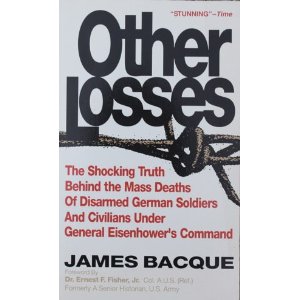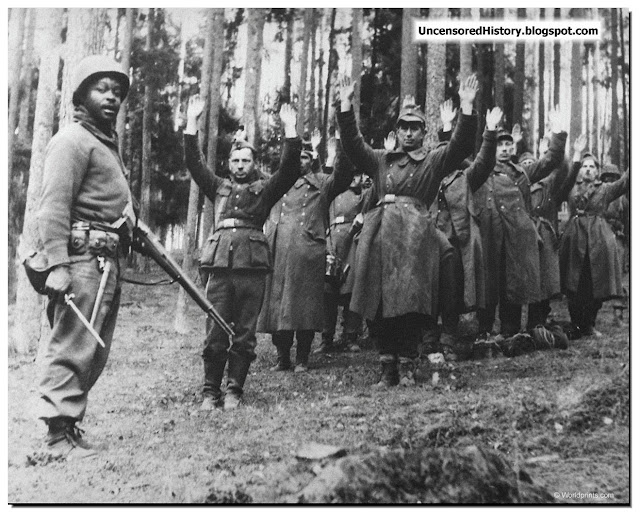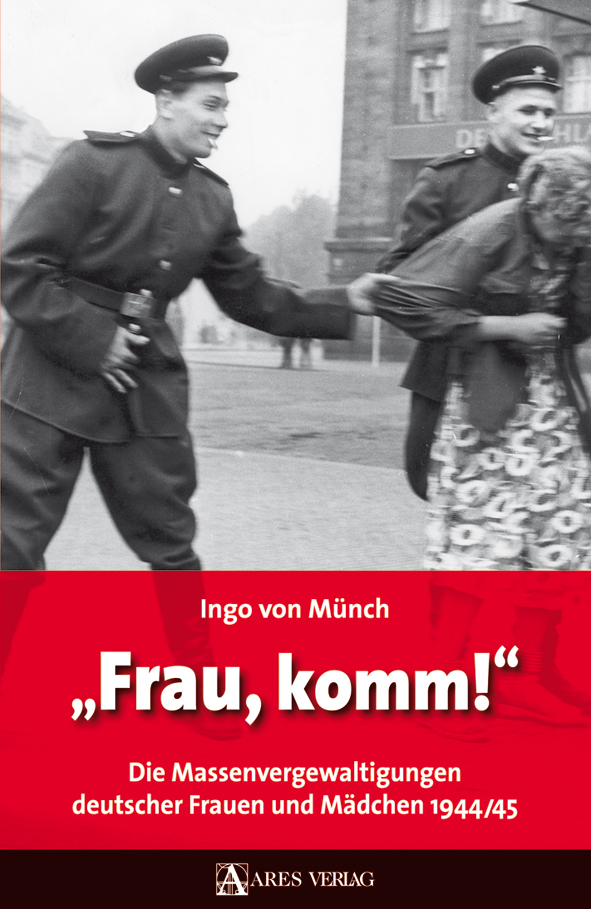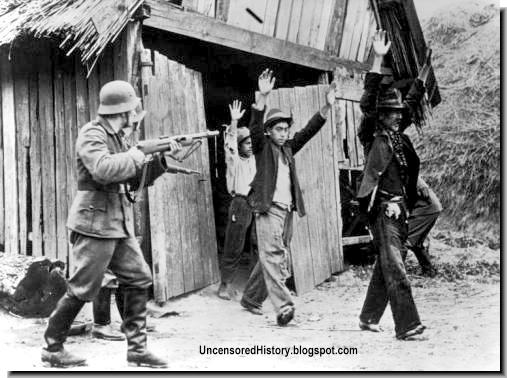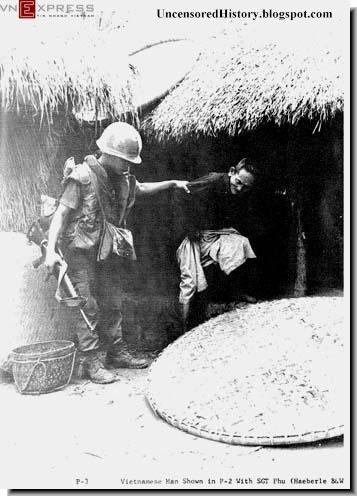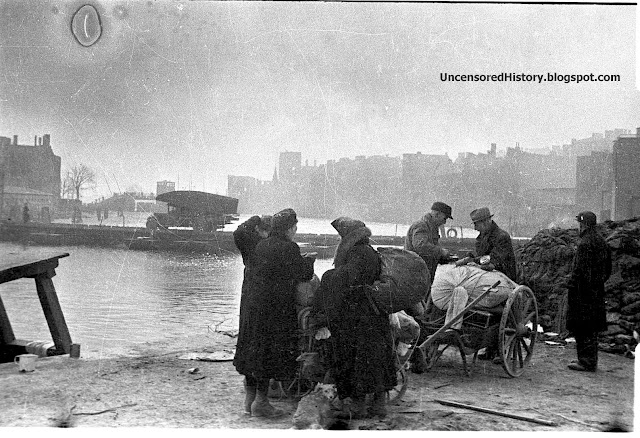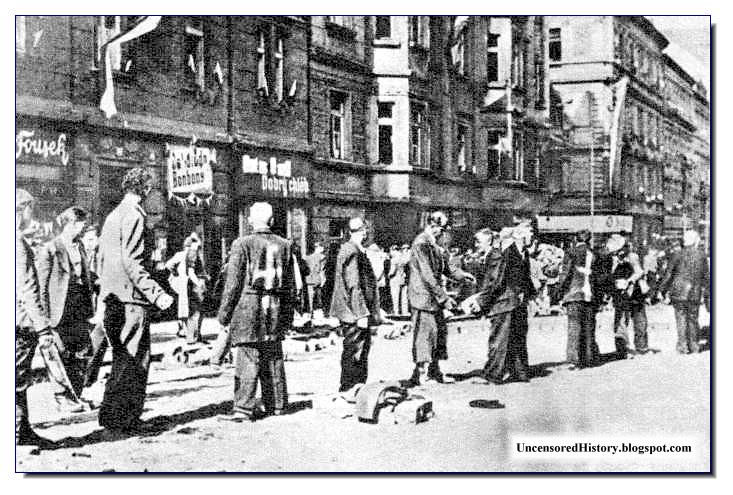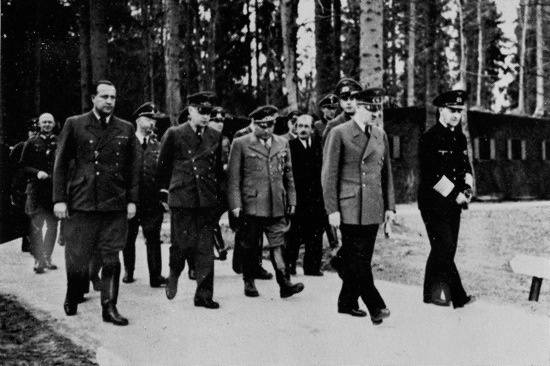Winston Churchill
The official attitude towards Germans was always much harsher in America than it was in Britain. At the Tehran conference, while the British advocated the splitting of defeated Germany into three administrative regions, Roosevelt wanted to break up the country even further. ‘Germany,’ he said, ‘was less dangerous to civilization when it was in 107 provinces.’ During the Anglo-American conference in Quebec in 1944, the US Treasury Secretary Henry Morgenthau put forward a plan to dismantle Germany’s entire industrial infrastructure, effectively returning the country to the Middle Ages. While Roosevelt approved this plan, the British only went along with it under duress.
From After the Reich: The Brutal History of Allied Occupation by Giles MacDonogh
Crimes and Mercies: The Fate of German Civilians Under Allied Occupation, 1944-1950
Probably the one question most frequently asked by people who express an interest in revisionism is: "Do you have any proof that Germans were tortured in order to extract confessions?"
It has been my experience to discover that even non-revisionist authors often pose this question as well, usually seeking to discredit the revisionist viewpoint. Due to the cloak of secrecy shrouding the allies use of torture, subterfuge, and intimidation, it has been quite difficult to document their record of abuse.
Nevertheless, over the years a number of able historians have done an admirable job in exposing the facts relating to the shocking use of torture by the allies. Admittedly, documentation is often difficult to obtain, due to the fact that the allied "interrogators" generally covered their tracks well, yet the persistence of historians and researchers interested in the truth has begun to pay off. The information which follows was culled from a variety of sources which should be easily accessible to parties interested in further research. Precisely because the documentation has been so scarce, a reconstruction of events will be necessary to prepare a proper foundation for argumentation, as the larger picture at this point is more important than the details. However, as the reader shall soon discover, details shall not be lacking.
If I were to point to one particular event which to my mind signaled the allies policy in regard to treatment of the vanquished, I would designate the meeting of the so-called "Big Three" at Teheran in 1943. As described by both Churchill and Elliott Roosevelt in their memoirs, "Stalin rose and proposed a blood-curdling toast. The strength of the German army depended, he said, upon fifty thousand high officers and technicians. His toast was a salute to shooting them, "as fast as we can, all of them." Churchill was horrified. Quick as a flash, he was on his feet; his face and neck were red, says Elliott Roosevelt, who was present. He announced that British conceptions of law and justice would never tolerate such butchery. Into this breach stepped President Roosevelt. He had a compromise to suggest. Instead of executing fifty thousand, perhaps "we should settle on a smaller number. Shall we say 49,500?" All the Russians at the table roared with laughter. So did the Americans, who were obliged to show proper appreciation for their chief’s "humor." Churchill left the table."
Undoubtedly, the President’s little grim "joke" was a source of great amusement for the Soviets, who were still laughing over the 14,000 Polish officers they had slain at Katyn, Miedjoye, and Kharkov Forest. Later, one of President Roosevelt’s interpreters said of his emaciated, crippled chief: "He looked sick, he acted sick, and he talked sick."
Lest anyone think that the President’s remark was made in jest, consider that less than one year later he was willing to ratify the notorious "Morgenthau Plan" , had it not been for the adamant objections of his Secretary of War, Henry Stimson.
In order to fully appreciate the attitude of the allies in regard to the treatment meted out to the defeated Germans, a brief review of events would be in order. To those who might object that the allies were too "civilized" to employ third degree methods on captured German officers to extract damning "confessions", I believe that certain criteria should first be investigated , presented, and addressed, namely:
1. How did the allies treat non-combatants? How were Germans treated who had nothing to do with the waging of the war? What was the allies policy in regard to women, the elderly, and in particular, German children?
2. How were German prisoners of war treated? Specifically, members of the Wehrmacht, Luftwaffe, etc. against whom no criminal charges had been preferred?
If the allies treated the defeated Germans with justice and equity, and can be proven so by documentation and the actual historical record, then the allegation that German POW’s were tortured and mistreated falls flat on it’s face.
The allies were particularly sensitive concerning the shooting of 50 allied fliers who had escaped from the Sagan POW camp in 1944. From the German point of view, many of these fliers were warned that should they attempt any more escapes, they would be shot. Aside from that, many of the escapees were caught in civilian clothes or else in German uniforms, thus leading the German authorities to conclude that they were spies. When one reflects on the fact that members of Otto Skorzeny’s commando group, which infiltrated American lines during the battle of the Bulge, were also shot upon capture even though they were wearing German uniforms under the American gear, then the shooting of the 50 terror fliers loses some of it’s punch. Nevertheless, German officers were executed for this "crime" while the allied crime of shooting the German "spies" went unpunished.
http://www.cwporter.com/gerund1.htm
The shooting of Americans at Malmedy was given the widest publicity, and those German units which participated in this battle were all brought before the allied inquisition, notwithstanding the fact that the allies had, in one incident shot down members of the Waffen SS in France in cold blood, and not one of the responsible parties was ever brought to justice.
At Dachau, American soldiers lined German guards up against a wall and shot them down without mercy. The Americans also allowed crazed inmates of the camp to savagely murder other guards who were stationed there. Often these victims were simply Wehrmacht officers who were left to guard the camp after the SS personnel absconded.
When the allied armies first entered German territory, did the victorious "champions of democracy" comport themselves with dignity and honor? Let the reader be the judge. What follows is just an excerpt from volumes of documents relating to the rampaging allied troops as they plundered, raped, and stole from the defenseless German population. The one crime most often committed by allied forces against German civilians in all sectors was forcible, violent rape, which is evidenced by a selection of the following reports. Few of the offenders were ever punished for this crime against women and children.
According to the publication "The U.S. Army in the Occupation of Germany":
"Of all the crimes committed by U.S. troops, the best....documented was rape, and it showed a "spiral increase" in the closing months of the war. Between July 1942 and October 1945, 904 rape cases were charged in the European theater, 552 of them in Germany. All told, 487 soldiers were tried for rapes committed in the months of March and April, 1945.(!)....By no means all the incidents were reported or, of those reported, brought to trial, and the conviction rate was relatively low."
"Reports of rape and robbery by U.S. troops piled up on the public safety officer’s desk.."
"The tension was greatest in areas where Negro troops were stationed, since they....frequently interpreted efforts to curb prostitution as another form of discrimination. In Kuenzelsau, Wuerttemberg, Negro soldiers of the 350th Field Artillery Battalion beat up the local jailer when he refused to release prostitutes being held for venereal disease treatment. Later the whole police in Kuenzelsau tried to resign after being threatened that they would be killed if they interfered with the prostitutes."
"Nearly all incidents involved liquor or women, often both. The population of vagrant women-which the Army inadvertently increased after November when it released penicillin for treating venereal diseases in German women, thereby shortening for some the "turn around time" from jail or hospital and attracting others who had been deterred by the fear of infection-was often at the root of soldier attacks on German officials and police....In one instance an American officer took an Austrian girl from Linz to Stuttgart, raped her three times, and then transported her to Ulm, where he turned her over to the military police on a charge of having improper papers."
"...the Negroes, believing they were not getting an equal share of the women, nursed grudges against both the Germans and the white Americans."
Take note that these are cases which have been confirmed by the Allied Occupation Authorities. Other reports may be offered to substantiate the above in greater detail:
"From the east came the Bolshevized Mongolian and Slavic hordes, repeatedly raping every captured woman and girl, contaminating them with venereal diseases and impregnating them with a future race of Russo-German bastards.
In the west the British used colonial troops, the French Sengalese and Moroccans, the Americans an excessively high percentage of Negroes. Our own method was not so direct as the Russian: ....we compelled women to yield their virtue in order to live-to get food to eat, beds to sleep in, soap to bathe with, roofs to shelter them."
The following was related by a catholic priest concerning a letter which was smuggled out of Breslau, Germany, September 3, 1945: "In unending succession were girls, women and nuns violated....Not merely in secret, in hidden corners, but in the sight of everybody, even in churches, in the streets and in public places were nuns, women and even eight year old girls attacked again and again. Mothers were violated before the eyes of their children; girls in the presence of their brothers; nuns in the sight of pupils, were outraged again and again to their very death even as corpses."
Making the world "safe for democracy", when our "Russian allies "liberated" Danzig they promptly liberated all the women of their virtue and chastity-by raping all-from small girls to ladies as much as 83 years of age....When women of the city pleaded for protection, a Russian officer told them to seek shelter in the Catholic Cathedral. After hundreds of women and girls were securely inside, the brave sons of mother Russia entered and "playing the organ and ringing the bells, kept up a foul orgy through the night, raping all the women, some more than 30 times."
According to Ralph Keeling, "The Russians were not alone in violating these principles. Police records of Stuttgart show that during the French occupation, 1,198 women were raped and eight men violated by French troops, mostly Moroccans."
According to the same source the average rate of venereal disease among Negro troops stationed in the American occupation zone in Germany was an amazing 771 per thousand! In attempting to explain this phenomenon to the American public, Lee Hills, foreign correspondent for the Chicago Daily news wrote:
"The other problem-and one so politically touchy that the war Department is afraid to remedy-is the heavy use of Negro American troops. The result, despite some superb Army leadership at the top, is that American prestige has dropped from its V-E Day peak. The top men in Germany, almost without exception, think it’s a mistake to have so many (42,000) Negro troops here.....They have a higher crime rate, a venereal disease rate several times that of the white soldier, and a worse record for mischief in general...Frankly, the worst problem comes from our colored troops going with white German girls. this stirs bitter hatred among German men. Many of our own soldiers feel almost as strongly about it."
There exists such a plethora of documentation regarding the mass rape of German women and children that I must refer the reader to these sources, which shall be included in a "recommended reading" section at the end of this article. Now that we have demonstrated how German women were treated by the allies, let us proceed to examine the treatment of children:
President Roosevelt again assumed the lead in directing allied policies in regard to the treatment of German civilians. His policy was reflected in a statement he uttered regarding the nourishment of the defeated. As Marie Antoinette once said of the French citizenry, "Let them eat cake", Roosevelt’s advice was "They should be fed three times a day with soup from Army soup kitchens."
As it turned out, the Germans were denied even this "luxury". According to the book "The U.S. Army in the Occupation of Germany", published by the Center of Military History, United States Army,...."military government did not provide relief for German refugees, at this stage not even for starving children."
So here we are confronted with a direct admission from a government source that starving German children were given no assistance whatsoever. Consequently we can only assume that they were left to starve. Often these children were orphaned. Their fathers were either deceased or else languishing in a POW camp. The mothers had either been raped and murdered or else victims of the appalling allied bombing offensive. If anything, allied policy was consistent. For instance, during the first few months of allied occupation in Berlin, typhus raged in the city, killing 65% of new-born babies. This particular strain of typhus was labeled by the Berliners as "hunger typhoid." Indeed, the death rate for infants rose to 660 per 1,000 in July! It is clear that allied policies and politicians were responsible for these outrages and crimes against humanity and against innocent children in particular. The allies didn’t "gas" them to death, which would have been more humane. They simply allowed them to starve to death.
According to Douglas Botting, author of "From the Ruins of the Reich", nineteen out of twenty babies died in the American Sector of Berlin in July 1945. According to the same source, in the British zone:
"The death rate of the very young and the very old reached a level not seen since the Thirty Years War nearly three hundred years before: in August, four thousand people died each day, compared with one hundred and fifty before the war...the dead had to be transported by wooden carts or hand stretchers, wrapped in rags or paper, as there were no coffins....there were still 53,000 orphans living like wild animals in holes in the ground, some of them one-eyed or one-legged veterans of seven or so, many so deranged by the bombing and the Russian attack that they screamed at the sight of any uniform, even a Salvation army one."
In view of the indescribable conditions noted above, the Americans charitably authorized the addition of a piece of meat or fish "one half the size of an egg"(!) when available. However, American servicemen were receiving over 4,000 calories a day during this same period.
Jews and Jewish DP’s received the next highest allotment: over 3,000 calories.
In the French zone conditions were even worse, if one can even imagine such a scenario. All over Germany, children were suffering from rickets and little bodies were covered with festering sores and boils, due to malnutrition, starvation, neglect and abuse. Often they had no shoes and went for days on end without a meal, while American soldiers carried out the orders of American Occupation authorities and dumped thousands of gallons of milk in the trash, rather than give it to the starving children. It was this incident more than any other which aroused the righteous anger and indignation of General George Patton, which resulted in the feud with Eisenhower, who relieved him of his post.
In Botting’s book, he quotes the statement of a British Officer named Christopher Leefe who at the time was serving with the Green Howards in Berlin. He relates the story of how a German youngster was apprehended stealing items from the officer’s barracks in order to buy food. Instead of having compassion on the boy, a Royal Major beat him repeatedly and unmercifully. The boy was approximately 10 years old, "thin as a bean pole, clothes hanging on him like sacks." The English bully struck this boy again and again screaming, "YOU FU**ING LITTLE KRAUT!"
What is most disturbing about this event is that not one person interceded on the boy’s behalf. What a particularly virulent hatred it is, to allow something so deplorable to occur without so much as a protest. Mr. Leefe was later quoted as saying:
"The point is that none of us could have cared a bit for that little boy. He was probably an orphan, his father dead on the Eastern Front, his mother rotting under the rubble of the bombed-out ruins, and here he was-starving and risking his life climbing up drainpipes in the middle of a British tank regiment. So what? We didn’t feel any compassion for him or any of the Germans. They had been public enemy number one. (!) So now we commandeered their horses, commandeered their Mercedes, commandeered their women. I would reckon that 60 or 70 percent of young Englishmen in Germany thought that way. Most of us were for having a bloody good time and believed we could get away with anything."
Aside from the infants who were left to die en masse, the conditions under which German youngsters were compelled to subsist were deplorable. If the allies were unconcerned about the fate of infants, German teen-agers and pre-adolescents fared no better-and often, their fates were worse than death. German boys who were inducted into the home army during the last days of the war received particularly brutal treatment at the hands of their captors. I have viewed many photos of such youngsters after they were taken captives and the condition they were in was unforgivable. Thin, pale, their faces bruised and bloodied, these unfortunate youngsters were often "escorted" by brutish looking military police twice their size. The book "Alliierte Kreigsverbrechen und Verbrechen Gegen die Menschlichkeit" (Allied War Crimes and Crimes against Humanity), re-published a photograph emanating from American newspapers entitled "Hitler Youth Walks the Last Mile." The photograph shows a youngster not any more than 13 or 14 years old being escorted by MP’s to a place of execution. The crime? "Suspicion" of spying. No trial, no evidence....simply shot to death for "suspicion" of spying. Why this youngster had to forfeit his life at the end of the war on such a flimsy pretext will be a mystery I will never be able to fathom. Yet I have already presented evidence of the brutal mistreatment a young boy of 10 suffered at the hands of the British, simply because he was starving.
American author Marguerite Higgins visited Germany during the time in question and later wrote of her experiences. In her book, "News in an singular thing" she described a visit to a GI "Interrogation Center" :
"The GI led us to the main door of the camp...Behind the bars of the cell we saw 3 uniformed Germans. Two of them, beaten and covered with blood, were lying unconscious on the floor. A third German was lifted up by the hair on his head, and I shall never forget, he had red hair like a carrot. A GI turned his body over and struck him in the face. When the victim groaned, the GI roared, "Shut your mouth, damned Kraut!" ....It turned out that for almost a quarter of an hour, the doubled rows of 20 to 30 GI’s stood aligned taking turns methodically beating the six captured Germans...It came out later that the worked-up GI’s had captured six young German boys, who had never even been members of the SS. The youngsters had only recently been inducted into a government work battalion. The boy with the red hair was 14 years old. The other 5 German boys in the cell blocks were between 14 and 17 years old."
Should anyone think that this was only an isolated case, then I will offer more evidence to prove that these beatings were endemic. These were not isolated occurrences. In fact, they were commonplace. Non-revisionist historians often take the position that such beatings never occurred, yet the evidence is overwhelming. And if this was the treatment meted out to the innocent-and to children in particular-it is only logical to assume that Nazis accused of heinous crimes were treated far worse.
The book "Vorsicht! Faelschung!" reproduces a photograph of 2 German youngsters taken after their "interrogation" by Allied investigators. The photo speaks for itself. The faces of the two youngsters are bruised, swollen, and bloody. In conclusion, the episodes recounted above for the benefit of the reader are only a small fraction among thousands of documented cases. The policy of the allies is clear. It was their intention to turn the entire German nation into one huge concentration camp. This policy was enforced throughout the breadth of the land. Germany’s youth were left to starve and languish. Thousands of youngsters, homeless and parentless, formed into "gangs" where they were forced to resort to crime simply in order to live. Young children of both sexes were compelled to resort to prostitution in order to buy a tidbit of food. The allies took no responsibility for the horrors and suffering they imposed upon another nation, nor have they ever apologized. In fact, when youngsters confessed to crimes without any coercion, the Americans seemed quite disappointed, as is evidenced by the following remark:
"The amusing thing about these youths and the Nazis we subsequently questioned was their complete willingness to betray one another once they were convinced that a friend had tattled, and it required very little "persuasion" to convince them that they had been betrayed. To the disappointment of some of our men, it was quite unnecessary to become physical in the interrogation."
TOTALS OF DEATHS
Minimum Maximum
Expellees (1945-50) 2,100,000 6,000,000
Prisoners (1941-50) 1,500,000 2,000,000
Residents (1946-50) 5,700,000 5,700,000
_________ __________
Totals 9,300,000 13,700,000
"Expellees" refers to the 16,000,000 ethnic Germans who were driven from their ancestral homelands in Poland, Hungary, Czechoslovakia, and elsewhere in Europe, at war's end.
These included mostly women and children and elderly men who, with a few belongings in hand and running the gauntlet of deep, local animosity, set out upon the open road toward the rump state of Germany.
"Prisoners" are, of course, the German POWs
"Residents" here refers to the German civilian population that survived the Second World War.
Preview

